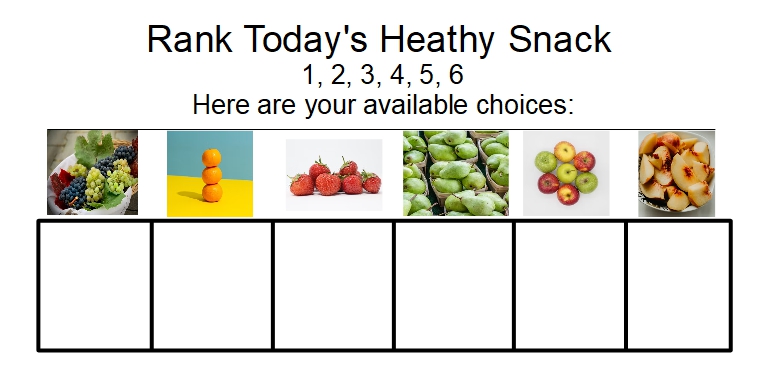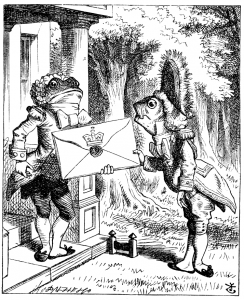A Whackadoodle discussion that explains ranked choice voting, and caucus voting, in a way that even a kindergartener can understand.
“So I’ve been thinking,” she said as she put her school books back into her backpack.
“Good, good,” I couldn’t help but tease. “Thinking is good.”
She sent me one of her dirtiest looks before continuing. “I’ve been think about the latest primaries. I noticed that a bunch of the states are starting to use that ranked choice voting you explained to me.”
“Yeah,” I prompted.
“Well whenever I hear it talked about on tv, the people are always either making fun of it, or complaining about how complicated it is. Have you noticed that?”
“I think that I might have, yes” I told her.
“Why do you think they do that?”
“Probably because it’s new to them, and people tend to distrust stuff that’s new.”
“But it’s not that complicated. You showed me how you could teach ranked choice voting to a kindergarten class. Remember? In that lesson we had by the bay, and you went on and on about how you thought schools should teach civics more like the way that they teach athletics. You know, teach kids the rules of the game, and then help them to actually get out and play it.”
“I remember.”
“Well, I think that we should write a post about ranked choice voting, where you explain it like you did by the bay. Then people can see how much better it is than the way we vote now, and how it’s not too complicated if you learn it the right way.”
“Why don’t we just refer people back to the article about our civics lesson by the bay?”
“No,” she shook her head. “You spent a lot of time explaining other things, like the filibuster, parliamentarians, bylaws. I think that we need to have one article just explaining ranked choice voting.”
“Alright captain,” I saluted her. “But if you remember, in order to explain ranked choice voting easily, I first had to explain caucus voting.”
“Right, so maybe we do both of those.”
“Can we at least quote from our earlier article?”
“Feeling lazy?”
“No,” I shook my head. “I’m just tired of explain the same thing over, and over again. So can we at least quote the parts of the article that deal with ranked choice voting, and voting by caucus?”
“If you insist,” she said with a tinge of disgust. She got out her phone, and began looking up the old article, “I think we should start the quote at when I asked…”
“So what is caucus voting?”
“It’s where everyone who wants to vote has to caucus in person to cast their vote.”
“Caucus?”
“A meeting, an assembly, a gathering, a convention, a conference, a congress. Again stop me when you’ve heard enough. A session, a get-together…”
“Enough,” she interrupted, shaking her hands in the air. “So how does a caucus vote work?”
I thought for a moment, searching for a easy example. “How about I explain it to you the same way that I would teach it to a pre-k class?”
“Yeah, I probably need an explanation at that level,” she smirked.
“Nah, it’s just the easiest way to explain.”
“Okay,” she folded her hands into her lap. “I will try to follow.”
“Well, if I wanted to explain how a caucus vote worked to a pre-k class, I would begin by saying that today will will hold a caucus vote to decided what our snack will be. I would then introduce their choices: grapes, apples, orange slices, strawberries, pears, or peaches. So far so good?”
“So far so good,” she agreed.
“Next, I would ask everyone who wants grapes to go stand next to the purple block, and everyone who wants apples to go stand next to the green block. Orange slices stand next to the orange block, strawberries next to the red, pears next to the white, and peaches next to the yellow. Still clear?”
“Um hum.”
“Then we would count how many people in each group. The group with the least number of people gathered next to their block, would lose their block and have to choose another block to stand by.”
“What if two of the groups had the same amount. Like they both had only one?”
“They would both lose their block, and be asked to pick another block.”
“So if they can’t have their first choice, they at least get to vote for their second choice,” she murmmured, beginning to sound impressed.
“Exactly, and then we count again, and again the block with the least number of people lose their block, and are asked to select another block.”
“So they at least get their third choice, right?”
“Yep, and you keep going unto you are down to two choices. The one with the most at that point wins.”
“But what if it’s a tie?” she asked, pointing out the obvious flaw.
“Well, believe it or not, there are some caucuses that have had that problem, and their rules say that the two opponents flip a coin to determine the winner.”
Her face fell in distaste. “That hardly seems a good way to chose.”
“Well, it is the way government sometimes works, and the point is to teach the rules of the game, so that once you become a voting citizens, you will know the rules of the game.”
“Who makes up these rules?” she asked, sounding a tiny bit disgusted.
“Well, generally they are written and voted into the bylaws by your elected representatives.”
“Bylaws?”
“The rules by which an assembly agrees to operate. Usually, the rules are the first thing a legislature votes on when it goes into session—right after they are sworn into office. Mostly they just adopt the rules from the last assembly, but sometimes amendments are made.”
“So the rules can change?”
“Sure, but only if your representatives can rally the votes.”
She nodded her head quietly. “So what was that last kind of voting you mentioned?”
“Ranked choice voting?”
“Yeah. How does that one work?”
“A bit like caucus voting, except it’s done with paper ballots.”
“Huh?
“Remember our pre-k snack example from before?” She nodded, so I continued. “Well, in ranked choice voting, instead of asking the kids to stand next to the blocks for everybody to see, you’d give them paper ballots which list of all their options, and then you’d ask them to rank those options from first choice to last choice.”
“You’d expect pre-k kids to read paper ballots?” she scoffed.
“No, I’d use pictures for the choices,” I explained. “And I’d help them to write their numbers like we do in pre-k all the time. In the end, it would look sort of like this:”

“So, you’d sort of be like their pole worker,” she smiled. “Helping them through the voting process.”
“Exactly,“ I agreed. She added nothing more, so I continued. “Anyway, once we had collected the ballots, we would separate them by all the first choices. The pile with the least votes would get picked up, and divided by their second choice. We’d do the same thing for the third choice, and so on until one of the choices had over fifty percent of the votes. That one would become the winner. Personally, I think ranked choice voting is the best way to get the best candidate.”
“Why? It sounds awfully complicated.”
“Not so complicated, and much more cost effective that a run-off. Plus, it has all the benefits of a caucus vote without any of the drawbacks.”
“How so?”
“Well, if you can afford to attend a caucus, they can be a lot of fun. Lots of people trying to convince each other who the best candidate is. But not everybody can afford to attend a caucus, so a great many people get left out. Ranked choice voting, on the other hand, can be done in advance. We collect the ballots just like we do now, and then sort them. It may take a little longer, but it ensures that even if you don’t get your first choice, you still have a change to have your vote counted—even if it is just for your second or third choice. Makes sense?”
“Makes sense.”
“In the end,” I shrugged in conclusion. “You get a candidate that more people accept, and not just the one who got the most first choice votes. Plus, more people feel like they’ve had their voice heard, and I think you end up with a less divisive result.”
She looked up from her phone, “I think we can stop the quote there,” she said.
“Sounds good to me,” I agreed. “Did you want to add anything more?”
She thought long and hard before answering. “I think that we should restate that ranked choice voting might be hard to explain, but is easy to understand when you take the time to show people how it works. People just need to take the time to show them how it works, instead of making fun of it, or complaining about how complicated it is. Once they understand ranked choice voting, I think they will also understand why it’s a better way to vote.” She paused before adding, “Is there something that you want to add?”
“Just that,” I sought for the right words. “I think the reason people resist ranked choice voting is because they are unfamiliar with it, and because of that unfamiliarity, they are uncomfortable with it. If we got people accustomed to it early in their lives, they might notice how much better its outcomes are. They might start expecting it, maybe even demanding it.”
____________
If you you enjoyed this post, please leave a comment below. It helps our algorithm.
It would also be great if you shared this post. It also helps our algorithm.
If you would like to join Lynn’s mailing list, or ask a Dear Navigator question click here

You can reach Lynn Marie Sager at
DearNavigator@gmail.com
Author:
- Navigating Life in a Whackadoodle World
- Finding Sense in a Whackadoodle World
- Teaching Logic in a Whackadoodle World
- Navigating Life Through Turbulent Tides
- A River Worth Riding: Fourteen Rules for Navigating Life

Thanks for explaining caucus. In Hawaii parties caucus. If you are an independent, you don’t get to vote in the primary. People who don’t understand why they can’t vote sometimes get really angry.
You are right. We need to get kids pertained in our government. If we don’t teach them the importance of voting and the rules of the game we are going to lose our democracy, or more precisely our democratic republic.
May I also point out that last night, August 31, 2022, Mary Peltola was elected to to the United States Congress, defeating Sarah Palin. Alaska used Ranked Choice Voting, so the people’s second choice made a difference. More Alaskans are happy with the result because if they didn’t get their first choice, they did at least get their second choice. Sara Palin’s first tweet was to blame Ranked Choice Voting for her failure, and a suggestion that she will reload to fight the will of the Alaskan people.